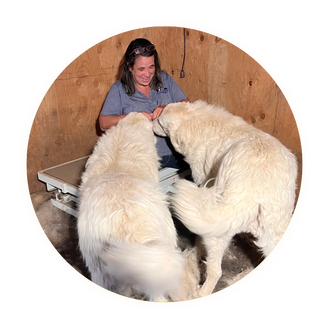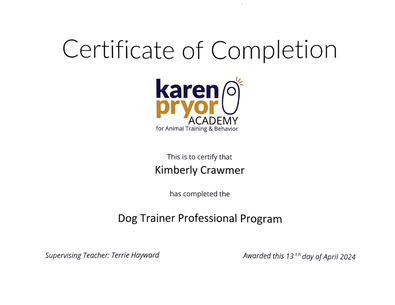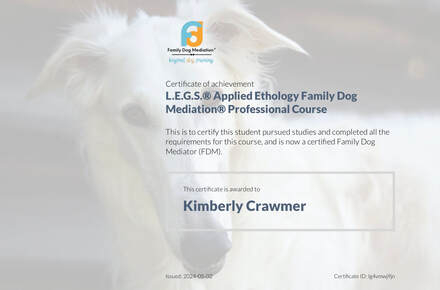Maremma Sheepdog Frequently Asked Questions
Commonly asked questions about Maremma Sheepdogs: Origins, appearance, temperament, training, health, and suitability for different livestock
Where did the Maremma Sheepdog originate?
Maremma Sheepdogs originated in central Italy, specifically in the Maremma region, where they were traditionally used to guard livestock, particularly sheep from wolves.
What is the average size and appearance of a Maremma Sheepdog?
Males typically weighing between 80 to 145 pounds and females weigh between 70 to 120 pounds. They have a sturdy build, a thick double coat and are white in color, with a regal, majestic appearance.
How does the Maremma Sheepdog compare to other, more common LGD breeds?
Maremmas are "close in" guardians, meaning they prefer to stick close to the stock instead of patrolling over vast areas like breeds such as Great Pyrenees do. They are generally very respectful of fencing and don't wander like most other LGD breeds. They still need a fence to serve as a boundary, but that fence usually doesn't need to resemble Fort Knox! This trait also makes them especially suitable for smaller farms than most breeds because they don't need acres and acres to keep them content. But they are equally suited to large ranches since they will stick close to the herd or flock as it moves about the property.
Are Maremmas suitable to small properties?
Because of their "close in" guarding style (they don't patrol and wander like most LGDs and are respectful of fences) Maremmas are exceptionally well suited to small farms and homesteads and can even do well in suburban neighborhoods, in the right home. They also don't tend to bark as much as some LGD breeds, though all LGDs bark to some extent so if you need a perfectly quiet dog then a Maremma is likely not the dog for you.
Are Maremma Sheepdogs suitable for all types of livestock?
Yes, Maremma Sheepdogs are known for their adaptability and versatility in guarding various types of livestock. They can guard sheep, goats, chickens, ducks, rabbits, and other animals. They have even been used to guard penguins and other endangered species!
However, proper training and supervision are important to ensure they develop a strong bond with the specific livestock they are tasked to protect and that they don't learn dangerous and inappropriate behaviors.
Do Maremmas Need Any Special Training to Guard Livestock or is it all Instinct?
It takes BOTH Nature and Nurture to produce outstanding Livestock Guardian Dogs. Sadly this is an area that most Maremma breeders fail miserably at. The result is dogs that are not suited to do the job and a lot of extra work for their owners. To learn more about how Livestock Guardian Dog puppies should be socialized and trained see the link below.
Maremma Sheepdogs originated in central Italy, specifically in the Maremma region, where they were traditionally used to guard livestock, particularly sheep from wolves.
What is the average size and appearance of a Maremma Sheepdog?
Males typically weighing between 80 to 145 pounds and females weigh between 70 to 120 pounds. They have a sturdy build, a thick double coat and are white in color, with a regal, majestic appearance.
How does the Maremma Sheepdog compare to other, more common LGD breeds?
Maremmas are "close in" guardians, meaning they prefer to stick close to the stock instead of patrolling over vast areas like breeds such as Great Pyrenees do. They are generally very respectful of fencing and don't wander like most other LGD breeds. They still need a fence to serve as a boundary, but that fence usually doesn't need to resemble Fort Knox! This trait also makes them especially suitable for smaller farms than most breeds because they don't need acres and acres to keep them content. But they are equally suited to large ranches since they will stick close to the herd or flock as it moves about the property.
Are Maremmas suitable to small properties?
Because of their "close in" guarding style (they don't patrol and wander like most LGDs and are respectful of fences) Maremmas are exceptionally well suited to small farms and homesteads and can even do well in suburban neighborhoods, in the right home. They also don't tend to bark as much as some LGD breeds, though all LGDs bark to some extent so if you need a perfectly quiet dog then a Maremma is likely not the dog for you.
Are Maremma Sheepdogs suitable for all types of livestock?
Yes, Maremma Sheepdogs are known for their adaptability and versatility in guarding various types of livestock. They can guard sheep, goats, chickens, ducks, rabbits, and other animals. They have even been used to guard penguins and other endangered species!
However, proper training and supervision are important to ensure they develop a strong bond with the specific livestock they are tasked to protect and that they don't learn dangerous and inappropriate behaviors.
Do Maremmas Need Any Special Training to Guard Livestock or is it all Instinct?
It takes BOTH Nature and Nurture to produce outstanding Livestock Guardian Dogs. Sadly this is an area that most Maremma breeders fail miserably at. The result is dogs that are not suited to do the job and a lot of extra work for their owners. To learn more about how Livestock Guardian Dog puppies should be socialized and trained see the link below.
How big do Maremmas Sheepdogs get?
Maremmas are one of the smaller LGD breeds. They range in size from around 70 lbs to close to 150 lbs, but on average they are around 90-100 lbs. But don't let their small size fool you. Devotion to their stock and tenacity are much more important than size when its comes to fending off predators. A pair of Maremmas is more effective than a single dog of larger breeds. Remember that Maremmas were bred to fight off wolves in their home country! Of course for very serious predator problems you may need more than two dogs.
The smaller size of the breed also makes them well suited to small properties and they eat less than larger breeds. Why feed more dog than you need to do the job?!
Are Maremma Sheepdogs prone to any specific health issues?
Maremma Sheepdogs are generally a healthy breed with few breed-specific health issues. However, like all dogs, they can be susceptible to certain conditions such as hip & elbow dysplasia, bloat, and certain eye disorders. Regular veterinary check-ups and a balanced diet are important for their overall well-being. You should only buy a puppy from a reputable breeder who screens their breeding dogs for genetic defects.
Are Maremma Sheepdogs good with children and household pets?
Yes, Maremma Sheepdogs are great with children and other pets when properly socialized and trained from a young age. They have a gentle and protective nature, making them suitable for families. However, supervision is always recommended when introducing them to other animals or small children.
How long do Maremma Sheepdogs typically live?
On average, Maremma Sheepdogs have a lifespan of 10 to 13 years. Providing them with a nutritious diet, regular exercise, proper veterinary care, and a loving environment can contribute to their overall health and longevity.
Are Maremma Sheepdogs easy to train? What kind of training works best with Maremmas?
Maremmas, like all LGD's, were bred to work independently a large part of the time, so they are very independent natured. However they bond very closely with humans they know and trust. Trust being the important part. Trying to get a Maremma to "obey" by making it "submit" not only won't work but it could be very dangerous for the human. Trust me, if you get into a fight with a Maremma the Maremma will win! What's more, fighting with a Maremma to get it to cooperate is totally unnecessary.
What Maremmas respond best to is Positive Reinforcement Training methods, such a Clicker Training. Clicker Training puts the dog in power and teaches them to make good choices. It becomes a fun and rewarding game to them to "train" their human to dole out tasty treats and other rewards for offered behaviors. They will meet you enthusiastically at the gate, excited to see what fun you have in store for them today!
Maremmas are one of the smaller LGD breeds. They range in size from around 70 lbs to close to 150 lbs, but on average they are around 90-100 lbs. But don't let their small size fool you. Devotion to their stock and tenacity are much more important than size when its comes to fending off predators. A pair of Maremmas is more effective than a single dog of larger breeds. Remember that Maremmas were bred to fight off wolves in their home country! Of course for very serious predator problems you may need more than two dogs.
The smaller size of the breed also makes them well suited to small properties and they eat less than larger breeds. Why feed more dog than you need to do the job?!
Are Maremma Sheepdogs prone to any specific health issues?
Maremma Sheepdogs are generally a healthy breed with few breed-specific health issues. However, like all dogs, they can be susceptible to certain conditions such as hip & elbow dysplasia, bloat, and certain eye disorders. Regular veterinary check-ups and a balanced diet are important for their overall well-being. You should only buy a puppy from a reputable breeder who screens their breeding dogs for genetic defects.
Are Maremma Sheepdogs good with children and household pets?
Yes, Maremma Sheepdogs are great with children and other pets when properly socialized and trained from a young age. They have a gentle and protective nature, making them suitable for families. However, supervision is always recommended when introducing them to other animals or small children.
How long do Maremma Sheepdogs typically live?
On average, Maremma Sheepdogs have a lifespan of 10 to 13 years. Providing them with a nutritious diet, regular exercise, proper veterinary care, and a loving environment can contribute to their overall health and longevity.
Are Maremma Sheepdogs easy to train? What kind of training works best with Maremmas?
Maremmas, like all LGD's, were bred to work independently a large part of the time, so they are very independent natured. However they bond very closely with humans they know and trust. Trust being the important part. Trying to get a Maremma to "obey" by making it "submit" not only won't work but it could be very dangerous for the human. Trust me, if you get into a fight with a Maremma the Maremma will win! What's more, fighting with a Maremma to get it to cooperate is totally unnecessary.
What Maremmas respond best to is Positive Reinforcement Training methods, such a Clicker Training. Clicker Training puts the dog in power and teaches them to make good choices. It becomes a fun and rewarding game to them to "train" their human to dole out tasty treats and other rewards for offered behaviors. They will meet you enthusiastically at the gate, excited to see what fun you have in store for them today!
How many Maremma Sheepdogs should I buy?
This subject is so important that it has a page all its own please go here for more information.
What is that colored stuff on your Maremma Sheepdog puppies and what’s it for?
We use Sprayline brand Sheep paint from Premier 1 Sheep Supply to mark our puppies, starting while they are still in the whelping box. This is so we can tell them apart, since they are all white and look a lot alike. Collars don’t show up under all that fur and can get lost or pose a strangulation hazard. With the spray we can tell at a glance which puppy is which, even from far away. That makes it very helpful when observing temperaments for eventual placements, as well as monitoring the health of the puppies. To read more about how and why we use Sprayline go to this blog post.
How Can I teach my Maremma Sheepdog not to bark so much?
Teaching a Maremma not to bark is like trying to teach a fish not to swim. Barking is a LGD's first and main defense mechanism against predators so trying to prevent them from barking is making them less effective as LGD's. Puppies and young dogs tend to bark more than adults as they haven't learned what is and isn't a threat yet. And single dogs often bark more than dogs with a partner out of boredom, stress and even fear. We don't try to "teach" our puppies and dogs not to bark because we believe they need to learn how to be discerning on their own. For more on that subject see the blog post called "Finding Their Bark".
Do Maremmas Sheepdogs Make Good Pets?
This is a hotly debated topic in the United States. The MSCA does not recommend Maremmas as companion dogs, even though in every other country in the world, including their native country of Italy, Maremmas are used as both pets and Livestock Guardian Dogs. There are good reasons for this recommendation but the simple fact is that there are lots of Maremmas that are kept as companion dogs, as well as lots of Maremmas that have failed as LGD's. What matters most is the reasons why someone wants as Maremma as a companion, their dedication to research the breed or their prior experience level, and the support they get from their breeder. Unfortunately most of the companion Maremmas in the United States come from Backyard Breeders, rescues and shelters, so breeder support is non-existent. While most of our Maremmas are working LGDs we do own one Maremma that is a full time companion dog. If you are interested in adding a companion Maremma to your family I urge you to reach out to us and we will help you decide if a Maremma is right for you.
This subject is so important that it has a page all its own please go here for more information.
What is that colored stuff on your Maremma Sheepdog puppies and what’s it for?
We use Sprayline brand Sheep paint from Premier 1 Sheep Supply to mark our puppies, starting while they are still in the whelping box. This is so we can tell them apart, since they are all white and look a lot alike. Collars don’t show up under all that fur and can get lost or pose a strangulation hazard. With the spray we can tell at a glance which puppy is which, even from far away. That makes it very helpful when observing temperaments for eventual placements, as well as monitoring the health of the puppies. To read more about how and why we use Sprayline go to this blog post.
How Can I teach my Maremma Sheepdog not to bark so much?
Teaching a Maremma not to bark is like trying to teach a fish not to swim. Barking is a LGD's first and main defense mechanism against predators so trying to prevent them from barking is making them less effective as LGD's. Puppies and young dogs tend to bark more than adults as they haven't learned what is and isn't a threat yet. And single dogs often bark more than dogs with a partner out of boredom, stress and even fear. We don't try to "teach" our puppies and dogs not to bark because we believe they need to learn how to be discerning on their own. For more on that subject see the blog post called "Finding Their Bark".
Do Maremmas Sheepdogs Make Good Pets?
This is a hotly debated topic in the United States. The MSCA does not recommend Maremmas as companion dogs, even though in every other country in the world, including their native country of Italy, Maremmas are used as both pets and Livestock Guardian Dogs. There are good reasons for this recommendation but the simple fact is that there are lots of Maremmas that are kept as companion dogs, as well as lots of Maremmas that have failed as LGD's. What matters most is the reasons why someone wants as Maremma as a companion, their dedication to research the breed or their prior experience level, and the support they get from their breeder. Unfortunately most of the companion Maremmas in the United States come from Backyard Breeders, rescues and shelters, so breeder support is non-existent. While most of our Maremmas are working LGDs we do own one Maremma that is a full time companion dog. If you are interested in adding a companion Maremma to your family I urge you to reach out to us and we will help you decide if a Maremma is right for you.
How well do Maremma Sheepdogs get along with strangers?
Some Maremma Sheepdogs can be reserved with strangers while others are more naturally friendly. They all have a natural instinct to protect their territory and herd or flock, even if their "herd/flock' only consists of humans or other household pets! Early socialization can help them become more comfortable around strangers, but they may still exhibit caution and wariness towards unfamiliar people. It's important to respect their nature and not force them to interact with strangers if they don't want to.
Do Maremma Sheepdogs require a lot of exercise?
Yes, Maremma Sheepdogs are an active breed and require regular exercise to stay happy and healthy. For Maremmas who are working LGDs they will exercise themselves if they have ample space and another Maremma buddy to play with. For companion Maremmas daily walks, playtime, and/or ample space to exercise and play are essential for their well-being. They are not well-suited for apartment living and thrive in environments with sufficient room to move around.
Do Maremma Sheepdogs shed a lot?
Yes, Maremma Sheepdogs have a thick double coat that sheds moderately throughout the year. Regular brushing is necessary to remove loose hair and prevent matting. They experience heavier shedding during seasonal coat changes. If you have a companion Maremma the "Maremma Snow" (shedding) will definitely be something you should be prepared to deal with. We suggest regular grooming and a Roomba!
I have a seven year old Maremma poultry guard. He has only ever been a guard. We are his third and final home. We do not know what he guarded on his original farm. All this to say I am bringing my three Nubian kids home next month. I would love your input or any resources on how to prepare him for the arrival of the kids.
If your dog is already successfully guarding poultry and is a mature adult he will probably do well with the goats, providing he has no history of aggression towards stock. How long have you had him? Is he loose with the birds?
The most important thing is to go slow and give lots of supervision and allow the animals to acclimate to each other. If the goats aren’t used to dogs they may act flighty, which could incite chase behavior in the dog. Normally I wouldn’t worry about that much in a dog that age but since you don’t know his history you should proceed slowly. Have the dog beside the goats but not with them until you are sure things are good. Use positive reinforcement training to reward the behavior you want to see. NEVER use corrections of any kind, not even verbal. You can and should interrupt inappropriate behavior but try to redirect the dog to something more rewarding than chasing. I know it’s hard when your dog is chasing an animal but it’s really important to try to remain positive. And if you work on that positive reinforcement training outside of the time you’re working with the goats then your dog will be more likely to listen to you when he is with them.
Some Maremma Sheepdogs can be reserved with strangers while others are more naturally friendly. They all have a natural instinct to protect their territory and herd or flock, even if their "herd/flock' only consists of humans or other household pets! Early socialization can help them become more comfortable around strangers, but they may still exhibit caution and wariness towards unfamiliar people. It's important to respect their nature and not force them to interact with strangers if they don't want to.
Do Maremma Sheepdogs require a lot of exercise?
Yes, Maremma Sheepdogs are an active breed and require regular exercise to stay happy and healthy. For Maremmas who are working LGDs they will exercise themselves if they have ample space and another Maremma buddy to play with. For companion Maremmas daily walks, playtime, and/or ample space to exercise and play are essential for their well-being. They are not well-suited for apartment living and thrive in environments with sufficient room to move around.
Do Maremma Sheepdogs shed a lot?
Yes, Maremma Sheepdogs have a thick double coat that sheds moderately throughout the year. Regular brushing is necessary to remove loose hair and prevent matting. They experience heavier shedding during seasonal coat changes. If you have a companion Maremma the "Maremma Snow" (shedding) will definitely be something you should be prepared to deal with. We suggest regular grooming and a Roomba!
I have a seven year old Maremma poultry guard. He has only ever been a guard. We are his third and final home. We do not know what he guarded on his original farm. All this to say I am bringing my three Nubian kids home next month. I would love your input or any resources on how to prepare him for the arrival of the kids.
If your dog is already successfully guarding poultry and is a mature adult he will probably do well with the goats, providing he has no history of aggression towards stock. How long have you had him? Is he loose with the birds?
The most important thing is to go slow and give lots of supervision and allow the animals to acclimate to each other. If the goats aren’t used to dogs they may act flighty, which could incite chase behavior in the dog. Normally I wouldn’t worry about that much in a dog that age but since you don’t know his history you should proceed slowly. Have the dog beside the goats but not with them until you are sure things are good. Use positive reinforcement training to reward the behavior you want to see. NEVER use corrections of any kind, not even verbal. You can and should interrupt inappropriate behavior but try to redirect the dog to something more rewarding than chasing. I know it’s hard when your dog is chasing an animal but it’s really important to try to remain positive. And if you work on that positive reinforcement training outside of the time you’re working with the goats then your dog will be more likely to listen to you when he is with them.
More Info On Maremma Sheepdogs
For More Info About Maremma Sheepdogs check out our blog or search our website for anything you want to know. You can also fill out our contact form and we will be happy to answer all your questions.







